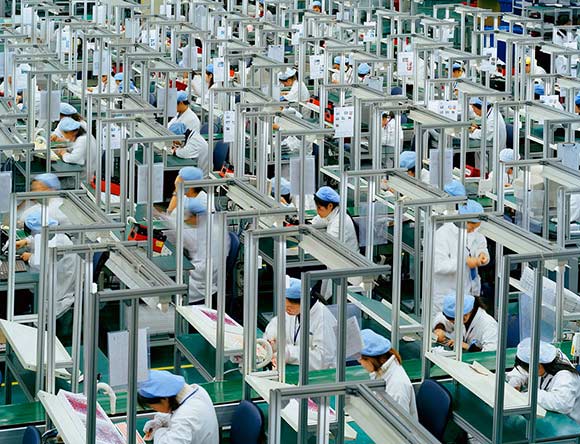Not long ago, Apple boasted that its products were made in America. Today, few are. Almost all of the 70 million iPhones, 30 million iPads and 59 million other products Apple sold last year were manufactured overseas. . .Let me just say – No it's not.
Apple employs 43,000 people in the United States and 20,000 overseas, a small fraction of the over 400,000 American workers at General Motors in the 1950s, or the hundreds of thousands at General Electric in the 1980s. Many more people work for Apple’s contractors: an additional 700,000 people engineer, build and assemble iPads, iPhones and Apple’s other products. But almost none of them work in the United States. Instead, they work for foreign companies in Asia, Europe and elsewhere, at factories that almost all electronics designers rely upon to build their wares.
“Apple’s an example of why it’s so hard to create middle-class jobs in the U.S. now,” said Jared Bernstein, who until last year was an economic adviser to the White House.
What kind of jobs does Apple and its suppliers have overseas? The NYT investigated and described a facility in China:
The facility has 230,000 employees, many working six days a week, often spending up to 12 hours a day at the plant. Over a quarter of Foxconn’s work force lives in company barracks and many workers earn less than $17 a day. When one Apple executive arrived during a shift change, his car was stuck in a river of employees streaming past. “The scale is unimaginable,” he said.What indeed? These are not “middle class jobs.”
Foxconn employs nearly 300 guards to direct foot traffic so workers are not crushed in doorway bottlenecks. The facility’s central kitchen cooks an average of three tons of pork and 13 tons of rice a day. While factories are spotless, the air inside nearby teahouses is hazy with the smoke and stench of cigarettes.
Foxconn Technology has dozens of facilities in Asia and Eastern Europe, and in Mexico and Brazil, and it assembles an estimated 40 percent of the world’s consumer electronics for customers like Amazon, Dell, Hewlett-Packard, Motorola, Nintendo, Nokia, Samsung and Sony.
“They could hire 3,000 people overnight,” said Jennifer Rigoni, who was Apple’s worldwide supply demand manager until 2010, but declined to discuss specifics of her work. “What U.S. plant can find 3,000 people overnight and convince them to live in dorms?”
Kraemer at al. (2011, here in PDF), by researchers at California-Irvine, Berkeley and Syracuse who have studied Apple’s supply chains, first for the iPod and then the iPhone and iPad, conclude:
Those who decry the decline of U.S. manufacturing too often point at the offshoring of assembly for electronics goods like the iPhone. Our analysis here and elsewhere makes clear that there is simply little value in electronics assembly. The gradual concentration of electronics manufacturing in Asia over the past 30 years cannot be reversed in the short- to medium-term without undermining the relatively free flow of goods, capital, and people that provides the basis for the global economy. And even if high-volume assembly expands in North America, this will likely take place in Mexico where there is already a relatively low-cost electronics assembly infrastructure.What has Apple done?
It has captured a significant fraction of the global market for mobile phones, as shown by the figure below from The Economist.
More importantly, Apple has created jobs in the United States. In 2006, before the iPhone was even on the market Apple as a company had less than 18,000 employees. In 2010, according to the NYT, Apple had 63,000 employees, with 43,000 in the United States. Even if we assume that all of its 2006 employees were in the US (they weren’t) Apple has created more than 25,000 jobs in the US. To put this data into perspective, at a time when the number employed in the US dropped by more than 5% Apple increased its US-based employment by more than 150%.
Rather than calling out Apple as an example of what is wrong in the innovation economy, we should be pointing to Apple as an example to emulate. The question that we should be asking is not how can we get Apple to hire more Americans, but rather, how do we get America to create more Apples?



